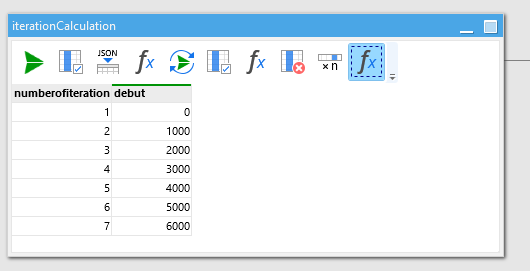OK, it seems like pagetocall isn’t really needed.
Here is your project edited to make it work. You will need to update your EasyMorph to v4.5 which was released yesterday in order to open the project (sorry, I don’t have an earlier version installed in my computer).
What was done:
I changed the number of records to pull from API at once (the batch size) from 10,000 to 1,000 in order to have a case when multiple requests are required because the total number of records in the API was just 6,871.
Also the batch size is now defined using a parameter so it’s easy to change it back to 10,000 throughout the workflow.
Fixed iterations
Iterations in EasyMorph is a way to arrange FOR…EACH type of loops. An iteration action performs as many cycles in such loop as there are rows in the input dataset. In your project the iteration in table “iterationRun” didn’t work because it always had 1 row regardless of batch size or total number of rows. This has been fixed. Now the “iterationCalculation’ table” calculates the necessary parameters for iterations. For instance, if the total number of records to fetch is 6871 and the batch size is 1000 rows per request then the iteration table should have 7 rows:

Also, the “Iterate table” action wasn’t really necessary. It could work, but its purpose is a bit more advanced for the type of iteration that you needed. The regular “Iterate” action is sufficient here.
I highly recommend reading our tutorial on iterations if you haven’t done it yet: https://easymorph.com/learn/iterations.html
Fixed API queries in module “responseToCSV”
In the API queries that pulled data, the debut URL parameter was missing, so I’ve added it. The debut request header wasn’t required so I removed it.
Also, the “Iterate Web Request” action now saves the response body into a file, instead of keeping it as a text cell. Keeping the whole CSV dataset (which can be megabytes of data) in just 1 cell is not recommended. Instead, the response body (CSV data) is exported into a temporary CSV file. Then it’s immediately re-imported back from the temporary CSV file into EasyMorph as a nice normal table. The temporary file is then deleted.
We don’t need to have CSV file(s) permanently, because we can keep all CSV data in memory in EasyMorph. Since the “Iterate” action in table “iterationRun” works in the “Iterate and append” mode, all result datasets of all iterations will be automatically appended into 1 dataset when the iteration finishes.
Removed CSV imports in the export group
To give the workflow a cleaner structure, I’ve moved tables with actions that export data into the target database into a separate group (tab) called “Export to SIREN”
In the table “SIREN_UPDATE” I’ve removed the CSV import actions because they are no longer needed. The whole dataset resides in-memory in EasyMorph, so no need to re-import it again. Actions “Export to database” and “Database command” don’t modify data in EasyMorph. Their output datasets in EasyMorph is always the same as the input datasets. They are “transparent” for data flow in EasyMorph.
Miscellaneous
- Removed extra columns with response attributes as they are not necessary and in order to have cleaner data
- Added a parameter for the temporary data folder - you may need to change it before running the project
- The API connector made embedded into the project. You may want to change it back to your connector from repository
- Requesting a token in every iteration in module "responseToCSV’ seems to be unnecessary and slows down execution. I suppose you can just reuse the token obtained in module “baseProcess”.
Here is the updated project:
InseeDailySIREN_DG.morph (40.2 KB)
If you have questions let me know.